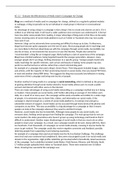AC 2.2 – Evaluate the Effectiveness of Media Used in Campaigns for Change
Blogs are a method of media used in campaigns for change, defined as a regularly updated website
or webpage. A blog is typically run by an individual or small group in informal or conversational
styles.
An advantage of using a blog in a campaign is that a blog is free to create and anyone can do it. If it is
written in an informal style, it will reach a wider audience since everyone can understand it. A formal
tone may deter some people from reading. A major advantage of blog posts is that they can be easily
shared, meaning users of social media platforms such as Twitter or Facebook who may not usually
have seen it can.
However, blogs can be extremely time-consuming and difficult to keep up to date. Furthermore,
blogs have become quite unpopular over the last 10 years. Most young people don’t read blogs and
are more likely to find out about/keep up with the campaign through social media. Accessibility can
also be an issue, as not everyone has access to or uses the internet. People also cannot be
‘recommended’ a blog like an Instagram page, likely leading to a lack of awareness of the campaign.
Blogs have a limited audience, being targeted towards the younger generation. However, many
younger people don’t use blogs, limiting awareness to a specific group. Younger people would only
really read blogs for specific interests, such as hair and beauty or baking. Some people may also
prefer to read formal text or articles rather than a short informal blog post.
An example of a campaign that used a blog is Green Peace. Their blog posts included images, videos,
and articles, with the majority of their posts being shared on social media. One was shared 969 times
in total and another shared 884 times. This suggests the blog was successful and effective in raising
awareness of their campaign and being seen by lots of people.
Another method of using media in a campaign is social networking, which is defined as the process
of gaining attention through social media networks. Social media allows users to create a public
account and interact with other users on the internet.
There are major advantages of using social media networking as a campaign method due to it being
so modern. Many people use social media, with Twitter attracting an average of 134 million users
daily. As a result of so many users, the campaign will be easily accessible and visible for a wide range
of people. It is extremely easy to share links, videos, and information on social media. If the
campaign is shared enough on a variety of social media platforms, it could go viral and gain a
substantial amount of support. Social media can be accessed through many devices like phones and
computers at any time. This easy accessibility is a big advantage for a campaign as that it means
people can look at the campaign whenever they want to and find it simply.
However, social media also has its downfalls. Although many people do use social media, not
everyone does, limiting certain groups from finding the campaign. The main group that do not use
social media is the older generations who haven’t grown up using technology and therefore find it
difficult to understand. Another major disadvantage of social media is that you must rely on other
people to share your campaign. As a result, your campaign would not be seen. Along with this, there
are hundreds, if not thousands, of campaigns on social media already, meaning it may be harder for
yours to get noticed. The campaign could also receive negative comments and feedback, possibly
deterring people from supporting it and reducing awareness.
An example of a campaign that used social media was the ALS Ice Bucket Challenge. This challenge
went viral and once someone had completed it, they were encouraged to post it on social media and
donate to the organisation. High profile celebrities got involved which dramatically raised awareness
of the campaign. Such celebrities included Justin Bieber, Matt Damon, Rihanna, and Nicholas Hoult.
17 million people uploaded their videos to Facebook alone. These were watched over 10 billion
times, showing how successful the campaign was.





